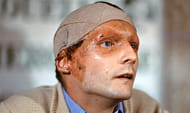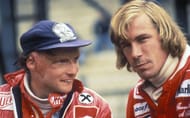Speed addict and rebel
Imagine driving a car. Let it be on a highway and at 100km/hr. Too easy? Now, let us make it a bit more difficult. Push on the accelerator and increase the speed rapidly to about 320km/hr. Still too easy? Perhaps a bit too fast for you taste. Now, let the straight highway be transformed into a curvy road with hairpin bends and sharp 90 degree turns. Scatter a few slopes and chicanes here and there. A bit difficult now? Perhaps too much.
But it is not over yet. Just for fun, let us make the weather a bit overcast and add some light rain and strong winds. Now put 20 more vehicles on the road around you. All doing 300km/hr and you eating their spray of road water as they drive ahead of you. Oh, I forgot to mention, your car doesn’t have a roof. Rain and tyre spray clog your vision as you try to avoid the plethora of speed maniacs around you. Also don’t forget to check tyre health regularly; going at 300km/hr is not a cakewalk and tyres can get blisters and the rubber may melt and fall off in chunks.
Is it tough enough for you now? Increasing the stakes a bit, also remember that this is not your or your friend’s uncle’s car. This car is built by a big bad-ass company and it costs $9.4million (55 crore).
Good luck not wrecking it! Yes, you guessed it right. You are driving a F1 car. While I am writing this article and people are sitting behind a laptop reading this article, there are speed addicts and rebels doing what was described above for a living. For a sport so intensely dependent on mechanical perfection of the cars, the driving skills of the driver is what differentiates the winners and non-finishers. Motorsport in general and F1 Racing in particular has produced many legends from Schumacher to Senna to Prost to Hunt. But one man remains the source of inspiration for many and an epitome of determination and sheer grit – Niki Lauda.
From the podium to hell and back again
Niki Lauda was an Austrian F1 racer who won the F1 drivers’ championship in 1975, 1977 and a superb comeback win in 1984.
Born into a wealthy family, Lauda decided to pursue a career racing despite his family’s grave opposition. He started racing in private cars and his driving skills were unlike anyone had seen before. He put in all his savings and bought his way up to the F2 level.
Though the Austrian impressed audiences with his elegance and technically perfect driving skills, he had a disastrous debut racing season and was soon out of money and neck deep in debts and even contemplated suicide. But heroes never give up and the soon-to-be legend Lauda picked up the pieces and clawed back his way into the racing world. All through his illustrious career, Lauda showed an inspiring no-nonsense work ethic.
In days when his fiercest rival James Hunt claimed to have slept with over 2000 women during their racing days and was usually with women even minutes before stepping into the car, the short Austrian showed immense commitment to improve the car and its performance. He spent majority of free time in the garages of Ferrari with low-rung mechanics and maintenance staff trying to understand every bit of the car’s functionality and making technical improvements.
This technical excellence combined with the maddening will to win and to do even the most menial tasks to accomplish it is what inspires the competitor in me. His modest attitude was very unlikely the way World Champions behave. That too F1 World Champions who have exuberant salaries and women ready to throw themselves at their feet.
A hero’s journey
The Austrian’s inspirational life is not only limited to his off-track behaviour and technical know-how. His tale of will-power and determination is of Biblical proportions. On that fateful day of 1st August 1976, at the Nurburgring Race Track of the German Grand Prix, there occurred one of the most lethal accident in all of the motorsport.
In the 2nd lap the Austrian’s Ferrari 312T2 snapped to the right and slammed into the fencing. Lauda was going at more than 200km/hr and the car bounced off the fencing and came on the track again directly on the path for a group of 5 cars blazing towards the wreckage at 250km/hr Herald Ertl and Brett Lunger both hit the ruined Ferrari with Niki still trapped in it. Lauda was struggling to get his seat belt undone and endured the flame ball for more than 2 minutes sitting inside the car while the fellow drivers attempted to douse the flames.
The blaze melted the foam of his helmet, burned his scalp and an ear and the toxic fumes he inhaled chemically burned both his lungs. Through the entire ordeal Lauda was conscious and tried to get out of the car. Finally when the fire was extinguished, he had drifted into coma and he was airlifted to a burn ward from where his recovery and comeback was to become legendary. Ferrari demonstrated the cut-throat nature of racing business and lack of apathy for their driver and immediately hired a new driver even before Niki reached the hospital. Lauda underwent extensive surgeries and skin grafting on his scalp burns.
His championship rival, the flamboyant ladies-man James Hunt won 2 races during the time Lauda was undergoing treatment and thus took a serious lead over him in the points table. Fierce sportsman at heart, Lauda, against all medical advice, appeared at the pre-race press conference at Monza just 6 weeks later and decided to race. His return was no doubt a medical miracle and inspired millions to rally with the now underdog Austrian. He raced in blood soaked bandages and intense pains and finished fourth in the race thereby defining an incredible comeback in sport history.
Lauda fought his way back to make up for the lost points but ultimately lost the championship to Hunt by a single point in the final race to the season. He won the championship the next year and the temperamental driver returned years later to win his third championship in 1984 with McLaren.
Inspiration and legacy
Lauda’s technical-professional approach and reliance on nothing but his driving abilities motivated many a race drivers. He knew his sport, he knew his car and he knew he was paid only to one thing – win. And so he did. This responsible attitude draws similarities with mine. I am inspired by him because there are very few people in the world to take winning so seriously. Very few who are so full of humility, passion and such ungodly determination.
I know of no other sports person who has suffered from so much physical pain and put in a Herculean effort to come back and do what a talented sportsman does best – win. Lauda lived to tell the tale and went on become a successful author and a businessman founding an airline in his name. He has also held a role as a consultant for Ferrari. Though people may feel that multi-billion dollar football clubs with one dismal season are sources of inspiration or they may be inspired by perpetual winners, I feel that true inspiration comes from those who are in beaten into the corner, the underdogs, the media-targets and those who bear all odds, criticism and even physical pain to come back and silence all competition.
Lauda and his famous come back is definitely what inspires me the most. It teaches me that no matter how much the pain, the pleasure of competing and winning is the greatest of all. And if you are not inspired by his tale of a man’s victory over pain, you either are living an awesome Usian Bolt-esque or Federer-esque life or perhaps you have just set your standards a tad higher.


